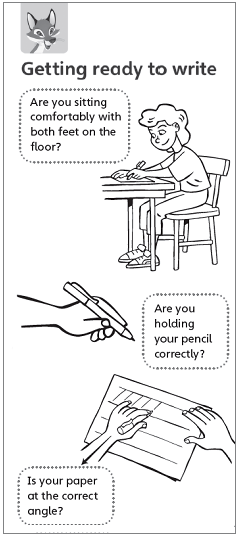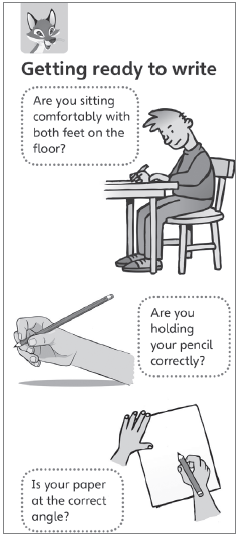Handwriting
Handwriting can sometimes be a frustrating thing to learn! But there’s a lot you can do to help. Support your child to get into good habits early and they’ll really benefit later in their school life – and beyond.
How to help at home
Here are some ways you can support your child as they practise their handwriting:
1. Check the pencil grip
Make sure your child adopts the correct pencil grip from the start – it is almost impossible to correct bad habits later.
2. Are you sitting comfortably?
When your child is writing, make sure they are sitting comfortably with their feet touching the floor (or a footrest). Writing is easier when you have a stable body.
3. Match the school
Be sure to find out what handwriting style your child is learning at school. Consistency is key, so it is important not to correct something that you think is an error but that is actually part of the style your child is learning.
4. Write in the sand
Give your child opportunities to do some non-permanent writing. This takes the pressure off early writers – if their handwriting isn’t perfect, they can just wash or brush it away and start again.
Write in the sand at the beach. Write in the mud at the park. Fill a clear sandwich bag that closes with some washing-up liquid and glitter; get your child to write (gently) on this. Ask your child to write letters or words on your back with their finger – can you guess what it is?
5. Get crafty
Continue to encourage your child to draw, colour, paint, and do crafting activities at home using a range of different materials. These activities all provide opportunities to develop control, fine motor skills, and hand-eye coordination.
Add some writing to the crafts – can they write with chalk, paint brushes or crayons? Can they make an attractive sign for their door or books?
6. Practice makes perfect
Good handwriting needs lots of practise. Practise handwriting with your child a few times every week – perhaps using the week’s spelling words. This will help them to develop good habits and strong muscles in their hands (and good spelling). Use special handwriting paper to check the position of each letter.
7. Write, write, write
Create as many opportunities as you can for your child to write:
-
- Get your child to write a shopping list or a short note to stick on the fridge. They could write events on the calendar, make greetings cards for family members, write out recipes or song lyrics, and so on. Try to find opportunities that link to their interests.
- Give your child the chance to make their very own book! Fold a few sheets of paper in half and staple down the length of the fold. Suggest that they fill it with their own story and pictures. It could be based on one of their favourite stories, or get them to fill in with pictures and captions about their favourite animal, superhero or footballer.
- Encourage your child to keep a diary, writing a sentence or two for every day. They might feel more enthusiastic about this idea if you let them decorate and personalise a plain notebook to make it their own.
What your child will learn
Click on the links below to find out about the handwriting goals for each year of Primary School:
Handwriting in Year 1 (age 5–6)
In Year 1, your child will learn to:
-
- sit correctly and use the right pencil grip
- form lowercase letters in the correct way: starting in the right place, moving the pencil in the correct direction and finishing in the right place
- form capital letters in the correct way
- forming the digits 0–9
- understand which letters are formed in similar ways
- to leave a space between words.
Video: Pen Grip and Posture
Handwriting practise activities:
- Tripod grip for left-handers
- Tripod grip for right-handers
- Practise tramlines
- Words to practise in Year 1
- At home with Handwriting 1
- At Home with Handwriting 2
- Handwriting: Capital Letters
- Handwriting Monsters
Handwriting acitivity books:
Handwriting in Year 2 (age 6–7)
In Year 2, your child will learn to:
-
- form lowercase letters of the correct size relative to one another
- start using some of the diagonal and horizontal strokes needed to join letters
- understand which letters, when next to one another, are best left unjoined
- write capital letters and digits in a size that matches the size of any lowercase letters
- understand which letters are formed in similar ways
- use the correct spacing between words.
Handwriting practise activities:
Handwriting activity books:
Handwriting in Year 3 (age 7–8)
In Year 3, your child will start developing fluent handwriting skills, making their writing more consistent and easier to read. They will practise:
-
- writing neatly and legibly with letters that are all a similar size
- joining some letters
- deciding which letters to join and which letters not to join
- keeping their writing lines horizontal and keeping the space between lines parallel and consistent
- keeping the downstrokes of their writing upright and parallel
- making sure that descenders of one line do not touch the ascenders of the line below.
Handwriting practise actvities:
Handwriting activity books:
Handwriting in Year 4 (age 8–9)
In Year 4, your child will continue to work on their fluent handwriting skills, making their writing more consistent and easier to read. They will practise:
-
- writing neatly and legibly with letters that are all a similar size
- joining some letters
- deciding which letters to join and which letters not to join
- keeping their writing lines horizontal and keeping the space between lines parallel and consistent
- keeping the downstrokes of their writing upright and parallel
- making sure that descenders of one line do not touch the ascenders of the line below.
Handwriting practise activities:
Handwriting in Year 5 (age 9–10)
In Year 5, your child will develop fluent, joined-up writing. This includes:
-
- deciding whether or not to join specific letters
- keeping letters of a consistent size
- choosing whether it is best to write with a pen or a pencil.
Handwriting practise activities:
Handwriting in Year 6 (age 10–11)
In Year 6, your child will build on their Year 5 handwriting skills and continue to develop fluent, joined-up writing. This includes:
-
- writing neatly and clearly
- deciding whether or not to join specific letters
- choosing whether to use a pencil or a pen.



